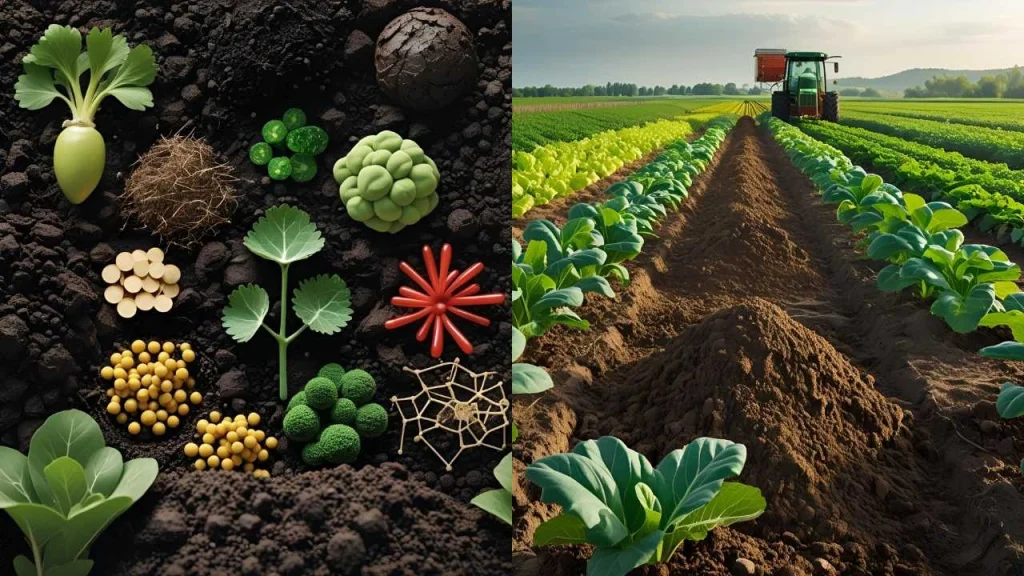What are biofertilizers and why do we need them?
They are substances that naturally help plants grow. These biofertilizers contain living microorganisms such as bacteria, fungi and algae. These microorganisms increase the soil’s nutrient content, which helps plants grow. Biofertilizers, unlike chemical fertilizers are safe for both the environment and humans.
Biofertilizers are not chemical fertilizers that directly feed plants. They make nutrients available to the plants. They help improve soil health, and crops grow stronger and healthier without harming the environment. Biofertilizers are being used by farmers around the globe to produce food in a more environmentally friendly and safer way.
Learn more about biofertilizers, their types, advantages, and how they are used. This is the key to a chemical-free, healthy future.
How Do Biofertilizers Work

They are made up of good bacteria and fungi. They multiply when you apply them on the soil or seed. These microbes work by:
- Fixing Nitrogen in the soil that plants require to grow.
- Organic matter is broken down to release nutrients.
- Make phosphorus available to the plant roots.
- Improve soil structure to improve water-holding capacity
- By producing plant hormones, you can boost root growth.
Biofertilizers restore a natural balance to the soil, reducing the need for chemical fertilisers. They improve soil quality over time and increase plant productivity.
Want To Know About Which Business Idea Would Be Better For You?
Go Through Our Startup Selector Tool
Types Of Biofertilizers
Biofertilizers are classified according to the microbes and nutrients they contain.
Nitrogen-Fixing Biofertilizers
These biofertilizers are made up of bacteria such as Azospirillum and Azotobacter. They fix nitrogen in the air and convert it into a form plants can use.
- Useful when: Rice and wheat, maize and pulses.
Phosphate-Solubilizing Biofertilizers
This microbe can dissolve phosphorus so that plants absorb it. It is crucial because phosphorus can be locked up in soil.
- Useful For: All Crops, Especially Fruits and Vegetables
Potassium-Mobilizing Biofertilizers
This organism helps release potassium from soil mineral, making it easier to absorb by plant roots.
- Useful when: Potato, banana, and sugarcane.
Mycorrhizal Fungi (VAM)
These fungi work in partnership with the roots of plants. They penetrate the root system to increase surface area.
- Useful to: Plantation crops and flowers, trees, and other plantations.
Cyanobacteria is a blue-green algae
They are water-loving bacteria that fix nitrogen in paddy and other wet environments.
- Useful For: Rice, and other Wetland Crops
Compost Biofertilizers
These are bacteria and fungi which help compost to break down faster and become richer in nutrients.
- This is useful for: Organic agriculture, home composting and kitchen gardens.
Read More: How to Start a Bio Coal Briquettes Manufacturing Business
Benefits of Using Biofertilizers
Biofertilizers have many benefits for farmers as well as the environment.
Environment-Friendly
They don’t pollute the air, water or soil. They help to protect the environment by reducing harmful chemical inputs.
Improves soil health
Over time, they increase the number and diversity of microbes and soil structure and texture.
Cost-Effective
Biofertilizers cost less than chemical fertilizers. Biofertilizers also reduce future farm costs by improving the soil naturally.
Safety for humans and animals
Biofertilizers do not have any harmful chemical residues or side effects. The biofertilizer is safe for pets, livestock, and children.
Increases Crop Yield
They can help plants grow stronger, better resist disease, and produce food of higher quality.
Restores soil balance
They restore the soil’s natural balance, which is often disturbed by the overuse of chemical fertilizers. Biofertilizers create a healthier ecosystem.
Climate Change: Helps to Combat Climate Change
These products reduce greenhouse gasses caused by synthetic fertilisers and promote sustainable farming.
Related Articles: How is CRISPR changing the future of Genetically Engineered Crops in India?
How To Use Biofertilizers

There are many different ways to use biofertilizers. Most commonly, biofertilizers are used in:
Seed Treatment
- Mix the biofertilizer and water together, then coat the seeds.
- Before sowing, dry them for 30 minutes in the shade.
Applying Soil
- Combine biofertilizer and compost or farmyard waste.
- Spread evenly on the field either before or during planting.
Root Dipping
- Prepare a biofertilizer solution using water and biofertilizer.
- Before transplanting, dip the roots of your seedlings into this mixture.
Foliar Spray
- You can spray some biofertilizers directly onto the leaves of plants by mixing them with water.
The application of these methods is simple and does not require any special equipment or tools.
When And Where To Use Biofertilizers
- Before transplanting or before sowing will give you the best results.
- Ideal for natural, organic, and conventional farming.
- It is suitable for all types of crops: grains, vegetables, fruits and pulses.
- Use in potted plants, greenhouses, rooftops, farms, kitchen gardens and other places.
Storage And Handling Tips
Follow these safety and use guidelines to get the best results:
- Keep away from heat and sunlight in a dry, cool place.
- Use before expiry in order to make sure microbes are still alive.
- Do not combine directly with pesticides or chemical fertilizers.
- Use clean containers and hands to apply.
- Shake well before using if the liquid formulation is a gel.
Biofertilizers VS Chemical Fertilizers
| Features | Biofertilizers | Chemical Fertilizers |
|---|---|---|
| Source | Natural (bacteria, fungi, algae) | Artificial (synthetic chemical) |
| Effects on Soil | Improves soil health | Can soil be harmful in the long term? |
| Environment Impact | Eco-friendly and safe | Pollution of air and water |
| Cost | Cheaper | Costly |
| Residues in Food | No harmful residue | May leave chemicals |
| Long-Term Benefit | Yes, | No (only short term boost) |
| Compatible with Organic | Yes, | No, |
Read Our Biofertilizer Project Report
Common Myths About Biofertilizers
Myth: They are not as effective as chemical fertilizers.
Truth: Biofertilizers build soil health over time, but they work slowly.
Myth: They’re only for organic agriculture
Truth: Biofertilizers are suitable for all farming methods, including mixed and regular methods.
Myth: They’re expensive and difficult to find.
Truth: Biofertilizers can be purchased at affordable prices in local agricultural shops as well as online.
Myth: They spoil fast.
When stored correctly, they can last between 6-12 months.
Read Our Book On Manufacture Of Biofertilizer And Organic Farming
Conclusion: A Natural Choice for a Better Future
Nature’s gift for farming is biofertilizer. They are affordable, safe and good for our planet. They promote healthy crops and protect soil and water. Biofertilizers are an environmentally friendly and smart choice for any farmer or gardener.
Read More: Book on Biofertilizer and Organic Farming 3rd Edition
Biofertilizers have many advantages: they reduce costs, improve soil health and are good for the environment. They are simple to use and can be used for any type of crop. They promote a system of farming that respects the environment.
Biofertilizers are a great way to feed people and the planet without damaging the environment. Use them now to grow your crops naturally!
FAQs About Biofertilizers
Q1. Can I use biofertilizers for potted plants or my home garden?
They are ideal for kitchen gardens, balconies, and potted plants.
Q2. Are biofertilizers safe for children and pets?
They are non-toxic and 100% safe.
Q3. Do biofertilizers have a shelf life?
Typically, 6-12 months. Check the expiry date on the label.
Q4. Can I mix chemical and biofertilizers?
Mixing can destroy the beneficial microbes. Separately apply.
Q5. Do biofertilizers work in all types of soil?
They are effective, but only in moist organic soil.
Q6. Can they be used at any time of the year?
You can, but you should avoid extremes of cold or dryness.
Q7. How long will it take for me to see the results?
Some changes can be seen in as little as 1-2 weeks. The full results are visible in a single growing cycle.





